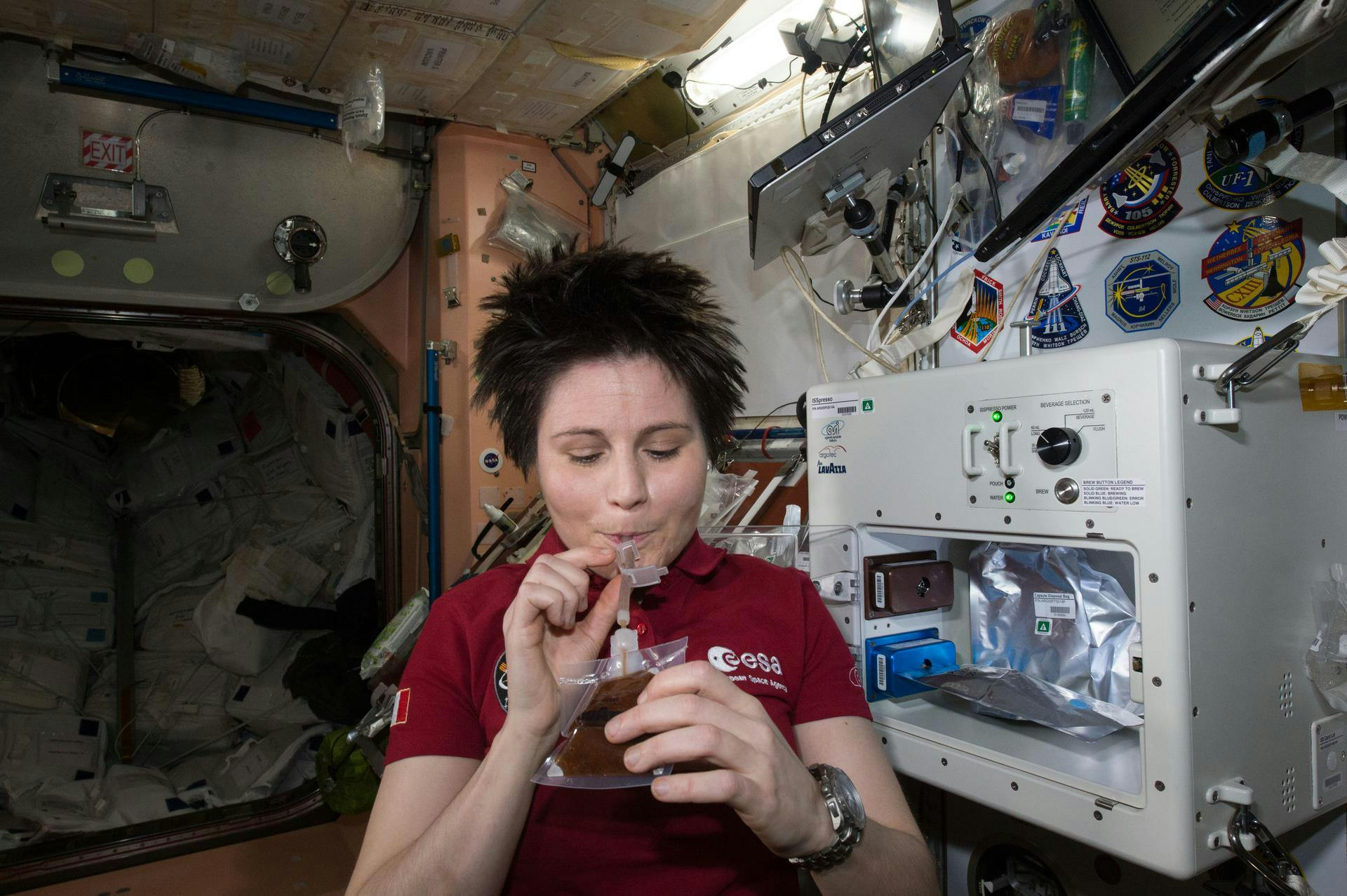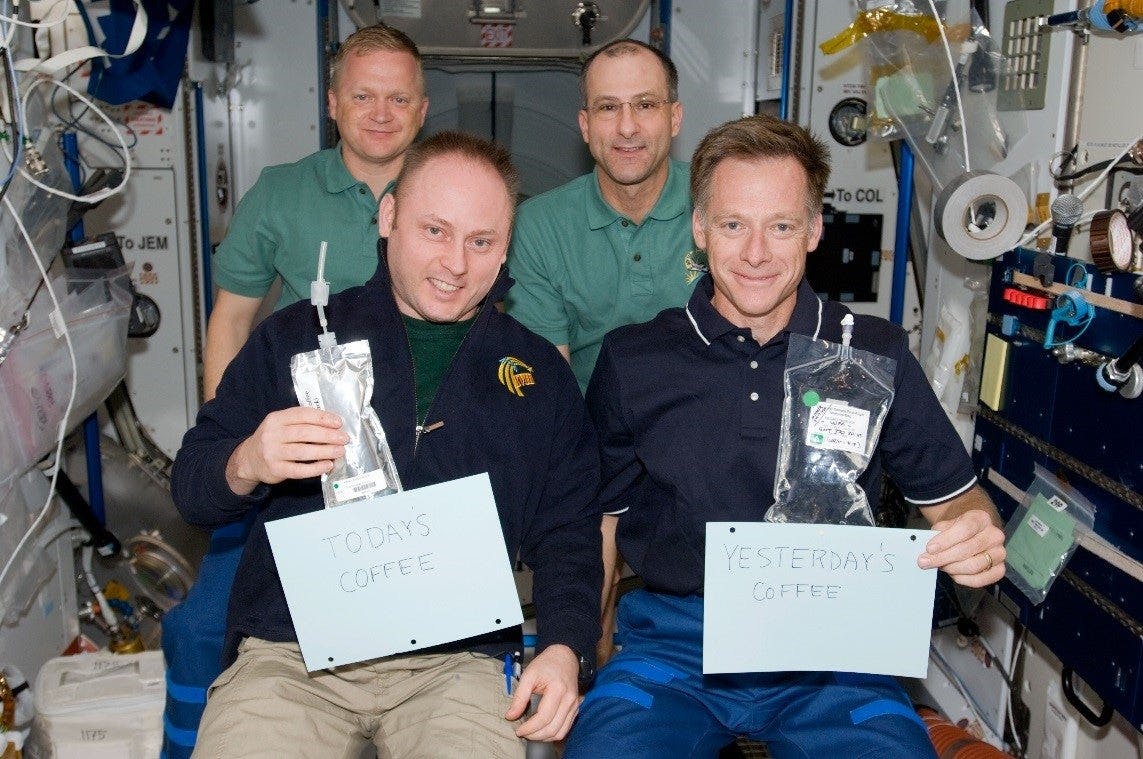Published Oct 1, 2022
How Scientists Answered the Demands for Coffee in Space
Drinking coffee in orbit isn't easy, but these researchers were up for the challenge.

NASA
You can hear the gurgle of gentle percolation, the smell of roasted beans wafting from that sunny kitchen corner. You hold the mug with both hands, feel the heat of your freshly brewed java, and take a sip. Warmth fills your groggy soul.
Well, on Earth, anyway.
Data from the National Coffee Association shows that coffee consumption in the United States was about three cups per day in 2018, while countries like Finland and Norway continuously surpass even that. We Earthlings love coffee! And no matter how and when we like to consume our coffee, there’s one thing we can all be thankful for on this International Coffee Day: gravity. Because drinking coffee in outer space? That’s no ordinary feat.
Mark Weislogel, a professor of Thermal and Fluid Science at Portland State University who worked with NASA for a decade, helps to describe the changes in how humans consume beverages in zero gravity. “Saliva changes in the mouth, sinuses are plugged and different in zero gravity, and your taste buds also change," he tells StarTrek.com. "Wafting doesn't happen!”
Even eating food with crumbs is a challenge in zero gravity, since crumbs can float away. Weislogel describes how pita bread is often used as the least crumbly bread, and still will need to be covered with ‘goo’ like peanut butter in order to keep it together.
“They’re using surface tension together to hold their solids together,” he says.
Eating in space is one challenge to consider, but liquids are a whole separate bag of beans due to contamination, surface tension, capillary action, and other factors that will change in a weightless environment. And with hot drinks, things become even more complicated.

NASA
“Espresso is such a complex drink, it’s going to behave differently,” Weislogel explains. Aspects of the beverage such as the all important crema, which occurs when air bubbles and oil mingle, fall apart completely in a zero gravity environment.
Nevertheless, cosmic coffee drinks have made outstanding strides in just the past five years. Weislogel was working on fluid design systems when he heard about astronaut Samantha Cristoforetti’s request for real espresso in space, and that a subsequent effort was in progress to make that happen with the invention of the ISSpresso.
Before the ISSpresso, drinking coffee in space was an instant-mixture concoction sucked through a straw. Developed by Lavazza and Argotec, the ISSpresso delivered an authentic espresso experience for astronauts aboard the International Space Station. Meanwhile, Weislogel and colleagues heard that the espresso machine being developed for Samantha Cristoforetti’s launch would still require astronauts to drink the beverage from a bag.
“Since we are from Portland, that’s a crime against culture!” he joked.
The added challenge was to develop a technology that allowed an astronaut to enjoy the coffee with some aspects we may take for granted on Earth, like smelling it and drinking from an actual cup. Microfluids Engingeer Dr. Andrew Wollman was a PhD student at the time of the development of the ISSpresso, and worked with Weislogel and IRPI to develop a new pour over coffee design, which includes using a syringe.

NASA
“The ISSpresso had a major flaw. It would brew coffee into a bag. You cannot enjoy fresh-brewed espresso sucking it from a straw,” Wollman wrote to StarTrek.com. “Our group sought to make an open container cup that would allow astronauts to enjoy aromatic beverages like on earth.”
To do this, a cup was designed that leveraged the geometry of the cup itself, along with the coffee's surface tension and wetting conditions to replace the role gravity plays when we drink a cup of coffee here on Earth.
Wollman was brought in to help develop a way to brew fresh coffee with a K-cup. “I modified the space cup developed for the Capillary Beverage Experiment and made a base that would receive a K-cup and a syringe of hot water to brew fresh coffee directly into the cup.”
He cites his influences for the project as pour-over, aeropress, Keurig, and ISSpresso brewing technologies.
Samantha Cristoforetti announced the first espresso in space on May 3, 2015 with a Tweet showcasing her sipping the beverage in her Star Trek Voyager uniform, accompanied by an on point quote from Captain Janeway: “Coffee: the finest organic suspension ever devised.''
With this, Lavazza declared that now astronauts could have a good, hot, steaming cup of coffee in space.
Still, the Federation starship mess halls come fully equipped. Replicators aside, how far away are we from having a seemingly regular dining hall in outer space?
“Way far away, because they [Starfleet] are simulating a gravitational field. But unless you can do that anything that pours will not pour along straight lines. If you’re in low gravity you’re in a disaster zone-- opening a bag of potato chips would be a crackup!” ” Weislogel advises.
Even with one astronaut’s request fulfilled, there was still plenty of work to be done in order to take coffee, and other beverages, where no man had gone before.
Many experiments done on space missions provide valuable data to us Earthlings for non-galactic applications. So, while the crew was up there, they decided to test a multitude of beverages, including lemonade and smoothies. The data gathered helped scientists learn about everything from liquid behavior to potential contaminants, and could then be used for verification and validation of engineering design tools.
“Everything from wind energy, to life support equipment in orbiting spacecraft, to microfluidics in point-of-care diagnostic lab-on-chip systems has a long way to go. I am excited about the emerging developments in fluid engineering and science. Fluid technology will look so different in the coming years, I cannot imagine it,” wrote Wollman.
For now, no replicators are needed to boldly brew in strange new worlds-- or simply just in orbit.
“Samantha Cristoforetti defied all the laws on space station. She took a scalding hot cup of espresso, in her Star Trek outfit, and drank it,” Weislogel beams. “Now the analysis can be used for things like urine processing, oxygen supply systems...it never would have happened if people didn't want a simple cup of coffee.”
Farah Joan Fard is a digital media specialist and writer who is especially fascinated with film theory and the intersection of art and society. She has written for Vanity Fair, Marie Claire, Bustle, and more. You may find her on Twitter @LaParadiddle.

